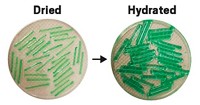Advertisement
Grab your lab coat. Let's get started
Welcome!
Welcome!
Create an account below to get 6 C&EN articles per month, receive newsletters and more - all free.
It seems this is your first time logging in online. Please enter the following information to continue.
As an ACS member you automatically get access to this site. All we need is few more details to create your reading experience.
Not you? Sign in with a different account.
Not you? Sign in with a different account.
ERROR 1
ERROR 1
ERROR 2
ERROR 2
ERROR 2
ERROR 2
ERROR 2
Password and Confirm password must match.
If you have an ACS member number, please enter it here so we can link this account to your membership. (optional)
ERROR 2
ACS values your privacy. By submitting your information, you are gaining access to C&EN and subscribing to our weekly newsletter. We use the information you provide to make your reading experience better, and we will never sell your data to third party members.
Business
Exploiting Biofilms
BASF Explores Using Bacterial Surfaces To Its Advantage
by Lisa M. Jarvis
June 9, 2008
| A version of this story appeared in
Volume 86, Issue 23
A lot of time and effort is spent trying to rid the world of biofilms, those slicks of bacteria that cling to the inside of pipes, the bottom of ships, and the surface of medical devices. But what if the sticky, stubborn nature of biofilms could be put to good use? Biofilms have long been applied as natural filters in industrial wastewater treatment systems, and researchers are now contemplating other ways they could be exploited.
"We know biofilms can be very stable, effective systems. In fact, a lot of conventional wastewater treatment systems use them, and they're very robust and efficient," says Phil Stewart, director of the Center for Biofilm Engineering at Montana State University.
BASF, the world's largest chemical company, is attempting to exploit biofilms to make key compounds via biocatalytic means. A biofilm can be seen as nothing more than a thin-film catalyst, says Bernhard Hauer, the firm's vice president of biocatalysis research. Hauer's group is trying to make viable reactors in which a chemical substrate is pumped over a support coated with a biofilm that converts the substrate into a product. Scientists at BASF hope to replace conventional fermentation processes and suspension-based cultures with reactors containing biofilms.
The process could offer several advantages over conventional fermentation. A biofilm is relatively stable, whereas batch fermentation requires starting or inoculating a reactor every other day, Hauer notes. Biofilms can offer high cell density, Stewart adds, resulting in a lot of reactivity in a small volume. Because of the fixed nature of biofilms, another advantage is that the solution coming out the other end of the reactor is relatively free of biomass. Moreover, the biofilm can be immediately reused as a catalyst.
So far, Hauer's group has constructed reactors filled with rings made of several materials—metals, glass, and ceramics—as a support on which the biofilms grow. After experimenting with more than 70 strains of bacteria, the scientists found that some thrived on specific supports, while others planted themselves on whatever was around. The fact that the films grow so easily on a wide variety of materials also creates complications; BASF has to use special filters on either end of the reactor to keep the bacteria from growing backwards into the feedstock.
In the end, Hauer says, steel rings proved to be a suitable support for these early systems, although BASF will revisit the support question if the systems are expanded to commercial scale. The trials also showed that the biofilm systems are stable for more than 100 days.
Once a system was worked out, Hauer's group first attempted catalytic conversion by trying to create R-2-butanol from a racemic mixture of 2-butanol. The group was able to isolate R-2-butanol using a biofilm but had trouble working at high concentrations. Still, the experiment proved the system was viable, and the researchers moved on to use a biofilm to oxidize ethylene glycol to glycoxylic acid. Other groups have tried this oxidation using Escherichia coli without success. BASF found a Pseudomonas-based biofilm that proved to be highly effective at turning out the desired product.
Currently, BASF scientists are working to increase the concentration of starting material while maintaining a stable system. They are also trying to identify the genes that metabolize glycoxylic acid and then use proteomics to block that process and improve the yield to 90%.
"Biofilms look promising," Hauer says. "Most industrial strains form them, they are metabolically active for a long time, there isn't fouling in the reactor, and the specific investment seems to be lower than batch fermentation."





Join the conversation
Contact the reporter
Submit a Letter to the Editor for publication
Engage with us on Twitter